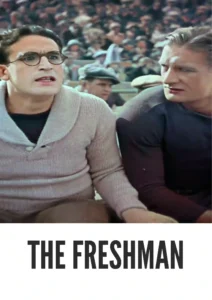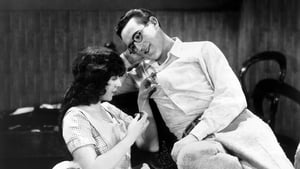Contact: info@alwanfilm.com
Video Sources 0 Views
- Watch trailer
- The Freshman 1925


Synopsis
Table of Contents
ToggleReview: The Freshman 1925 Colorized – A Timeless Comedy Classic Revived in Vivid Color

Introduction
“The Freshman” (1925) stands as a comedic masterpiece of the silent film era, showcasing the timeless talent of silent film star Harold Lloyd. In this article, we’ll explore the significance of this early colored version of the film, diving into its impact on audiences and its enduring legacy in the world of comedy.
Check The Full Colorized Movies List
Check Our Colorized Movies Trailer Channel
Understanding The Freshman 1925 Colorized: Director, Cast, and Genre
Directed by the visionary Fred C. Newmeyer and Sam Taylor, “The Freshman” (1925) exemplifies their mastery of silent comedy and visual storytelling. The film stars the incomparable Harold Lloyd in the role of a bumbling college freshman, whose misadventures on campus provide endless opportunities for hilarity and hijinks. Blending elements of slapstick humor, physical comedy, and heartfelt emotion, “The Freshman” (1925) remains a timeless classic that continues to delight audiences of all ages.
Exploring the World of The Freshman 1925 Colorized: Plot and Characters
At its core, “The Freshman” (1925) follows the misadventures of Harold Lamb, a naive and eager-to-please freshman who dreams of becoming popular on campus. However, his earnest efforts to fit in only lead to a series of comedic mishaps and misunderstandings, much to the amusement of his peers. Along the way, Harold encounters a colorful cast of characters, from his gruff football coach to his charming love interest, each adding to the film’s charm and humor.
The Art of Film Colorization
Film colorization serves as a transformative tool that breathes new life into classic movies, allowing audiences to experience beloved films in vibrant color. By digitally adding color to black and white films, colorization enhances the visual appeal of classic movies and introduces them to a new generation of viewers. With modern advancements in colorization technology, films like “The Freshman” (1925) can now be enjoyed in vivid detail, capturing the imagination of audiences in ways never before possible.
Early Colored Films: A Brief History
The history of colored films dates back to the early days of cinema, with filmmakers experimenting with various techniques to add color to their creations. From hand-tinted frames to early Technicolor processes, the evolution of colored film has been marked by innovation and creativity. As technology has advanced, so too has the art of colorization, with modern digital techniques offering filmmakers unprecedented control over the color palette of their films.
The Freshman 1925 and Its Early Colored Version
The decision to release “The Freshman” (1925) in a colorized format was met with both excitement and apprehension. While some welcomed the opportunity to experience the film in vibrant color, others expressed concerns about the potential impact on its visual aesthetic. Nevertheless, the early colored version of “The Freshman” (1925) offers viewers a fresh perspective on Harold Lloyd’s comedic genius, enhancing the film’s timeless appeal and introducing it to a new generation of fans.
The Debate Over Film Colorization
The debate over film colorization continues to divide audiences and critics alike, with proponents praising its ability to breathe new life into classic movies and introduce them to a new generation of viewers, while detractors argue that it compromises the artistic integrity of the original work. As the debate rages on, filmmakers and audiences alike are left to ponder the merits and drawbacks of colorization in the ever-evolving landscape of cinema.
Examining The Freshman 1925 as an Early Colored Film
As with any colorized classic, the impact of colorization on “The Freshman” (1925) is a matter of personal interpretation. Some may argue that it enhances the film’s visual appeal and immerses viewers in its world, while others may feel that it detracts from the stark beauty of the original black and white version. Regardless of one’s stance on the issue, there’s no denying the enduring power of “The Freshman” (1925) as a timeless comedy classic that continues to delight audiences with its timeless humor and heartfelt charm.
Influence and Legacy: The Freshman 1925 Colorized’s Impact on Cinema
“The Freshman” (1925) has left an indelible mark on the world of cinema, inspiring countless filmmakers and captivating audiences with its timeless humor and heartfelt storytelling. From its iconic scenes to its memorable characters, the film continues to resonate with viewers of all ages, reaffirming its status as a beloved classic of the silent film era.
Director’s Cinematic Legacy: Beyond The Freshman 1925 Colorized
Fred C. Newmeyer and Sam Taylor’s influence extends far beyond “The Freshman” (1925), with a diverse body of work that continues to captivate audiences around the globe. From their groundbreaking silent comedies to their innovative storytelling techniques, Newmeyer and Taylor’s films are celebrated for their wit, charm, and timeless appeal. Through their pioneering work, they have left an indelible imprint on the world of cinema, inspiring generations of filmmakers to follow in their footsteps.
Themes Explored in The Freshman 1925 Colorized
“The Freshman” (1925) explores a myriad of themes, from the trials and tribulations of adolescence to the universal desire for acceptance and belonging. Through its endearing characters and laugh-out-loud humor, the film invites viewers to embrace their inner misfit and celebrate the quirks and foibles that make us human. As audiences immerse themselves in Harold Lloyd’s hilarious escapades, they are reminded of the joy and laughter that can be found in even the most unlikely of circumstances.
Reception and Controversy Surrounding The Freshman 1925 Colorized
Upon its release, “The Freshman” (1925) received widespread critical acclaim, with many praising Harold Lloyd’s comedic brilliance and the film’s timeless appeal. However, the decision to release the film in a colorized format sparked debate among purists, reigniting the age-old discussion surrounding film preservation and artistic integrity. Despite the controversy, “The Freshman” (1925) remains a beloved classic that continues to entertain audiences of all ages, reaffirming its status as a timeless masterpiece of silent comedy.
Where to Watch The Freshman 1925 Colorized Online
For those eager to experience the comedic genius of Harold Lloyd in “The Freshman” (1925), the film is readily available on popular streaming platforms such as Netflix, Amazon Prime, and Hulu. Whether you choose to watch it in its original black and white format or the early colored version, “The Freshman” (1925) promises to delight audiences with its timeless humor and heartfelt charm.
FAQs About The Freshman 1925 Colorized
Q: Is “The Freshman” (1925) based on a true story? A: No, “The Freshman” (1925) is a fictional comedy that follows the misadventures of a hapless college freshman as he navigates the challenges of campus life.
Q: Who are the main actors in “The Freshman” (1925)? A: “The Freshman” (1925) stars silent film icon Harold Lloyd in the lead role, alongside a talented ensemble cast of supporting actors who bring the film’s colorful characters to life.
Q: What awards did “The Freshman” (1925) win? A: While “The Freshman” (1925) did not win any major awards, it received critical acclaim for its innovative storytelling, hilarious performances, and timeless humor.
Q: Why was “The Freshman” (1925) released in a colorized format? A: The decision to release “The Freshman” (1925) in color was made to introduce the film to a new generation of viewers and enhance its visual appeal for modern audiences. While the choice to colorize the film sparked debate among purists, it ultimately allowed “The Freshman” (1925) to reach a wider audience and ensure its continued relevance in the annals of cinematic history.
Conclusion
As we journey through the uproarious world of “The Freshman” (1925), let us celebrate its enduring legacy as a timeless comedy classic that continues to entertain and inspire audiences of all ages. Whether viewed in its original black and white format or the early colored version, the film’s timeless humor and heartfelt charm are sure to leave a lasting impression on all who encounter it. So, grab some popcorn, sit back, and prepare to laugh until your sides ache as you embark on a cinematic journey like no other with “The Freshman” (1925).










